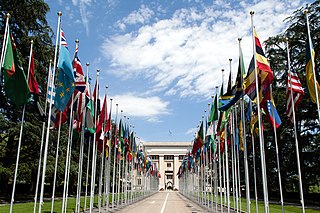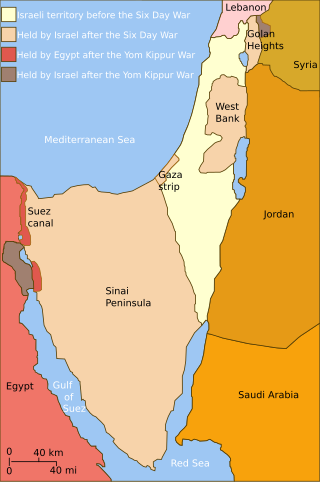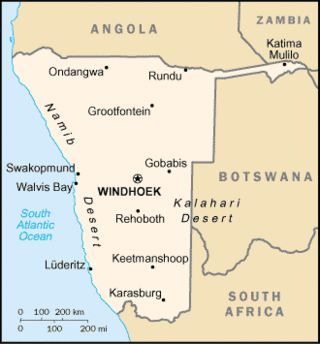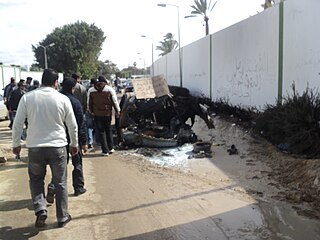
A United Nations Security Council resolution (UNSCR) is a United Nations resolution adopted by the Security Council (UNSC), the United Nations (UN) 15-member body charged with "primary responsibility for the maintenance of international peace and security".

United Nations Security Council Resolution 478, adopted on 20 August 1980, is the last of seven UNSC resolutions condemning Israel's annexation of East Jerusalem. UNSC res 478 notes Israel's non-compliance with United Nations Security Council Resolution 476 and condemned Israel's 1980 Jerusalem Law which declared Jerusalem to be Israel's "complete and united" capital, as a violation of international law. The resolution states that the council will not recognize this law, and calls on member states to accept the decision of the council. This resolution also calls upon member states to withdraw their diplomatic missions from the city. The UNSC resolutions followed two General Assembly resolutions regarding Israel's actions in East Jerusalem.

A United Nations resolution is a formal text adopted by a United Nations (UN) body. Although any UN body can issue resolutions, in practice most resolutions are issued by the Security Council or the General Assembly, in the form of United Nations Security Council resolutions and United Nations General Assembly resolutions, respectively.
United Nations General Assembly (UNGA) resolution 377 A, the "Uniting for Peace" resolution, states that in any cases where the Security Council, because of a lack of unanimity among its five permanent members (P5), fails to act as required to maintain international security and peace, the General Assembly shall consider the matter immediately and may issue appropriate recommendations to UN members for collective measures, including the use of armed force when necessary, in order to maintain or restore international security and peace. It was adopted 3 November 1950, after fourteen days of Assembly discussions, by a vote of 52 to 5, with 2 abstentions. The resolution was designed to provide the UN with an alternative avenue for action when at least one P5 member uses its veto to obstruct the Security Council from carrying out its functions mandated by the UN Charter.

United Nations Security Council Resolution 338 was a three-line resolution adopted by the UN Security Council on 22 October 1973, which called for a ceasefire in the Yom Kippur War in accordance with a joint proposal by the United States and the Soviet Union. It was passed at the 1747th Security Council meeting by 14 votes to none, with China abstaining.
Chapter VI of the United Nations Charter deals with peaceful settlement of disputes. It requires countries with disputes that could lead to war to first of all try to seek solutions through peaceful methods such as "negotiation, enquiry, mediation, conciliation, arbitration, judicial settlement, resort to regional agencies or arrangements, or other peaceful means of their own choice." If these methods of alternative dispute resolution fail, then they must refer it to the UN Security Council. Under Article 35, any country is allowed to bring a dispute to the attention of the UN Security Council or the General Assembly. This chapter authorizes the Security Council to issue recommendations but does not give it power to make binding resolutions; those provisions are contained in Chapter VII. Chapter VI is analogous to Articles 13-15 of the Covenant of the League of Nations which provide for arbitration and for submission of matters to the Council that are not submitted to arbitration. United Nations Security Council Resolution 47 and United Nations Security Council Resolution 242 are two examples of Chapter VI resolutions which remain unimplemented.

United Nations Commissioner for South West Africa was a post created by the United Nations General Assembly (UNGA) in 1966 to assert the UN's direct responsibility for South West Africa which was then under illegal occupation by apartheid South Africa.

United Nations Security Council Resolution 435, adopted on September 29, 1978, put forward proposals for a cease-fire and UN-supervised elections in South African-controlled South West Africa which ultimately led to the independence of Namibia. Importantly, it established the United Nations Transition Assistance Group (UNTAG) which oversaw the election and the South African withdrawal.
United Nations Security Council Resolution 276, adopted on January 30, 1970, after reaffirming previous resolutions and statements, the Council condemned South Africa's continued occupation of Namibia as illegal and decided to establish an ad hoc sub-committee to study the ways and means by which the Council's resolutions could be implemented. The Council requested all states and organizations give the sub-committee all the information and other assistance it may require and further requested the Secretary-General to give every assistance to the sub-committee.
United Nations Security Council Resolution 283 was a United Nations Security Council resolution adopted July 29, 1970. It was adopted by 13 votes to none, with France and the United Kingdom abstaining.

United Nations Security Council Resolution 342 was adopted unanimously on December 11, 1973. After noting with appreciation a report by the Secretary-General, the Security Council decided to discontinue further efforts on the basis of Resolution 309, and requested the Secretary-General keep them informed of any new developments concerning the question of Namibia.

United Nations Security Council Resolution 385, adopted unanimously on January 30, 1976, recalled previous resolutions on the topic as well as an advisory opinion of the International Court of Justice that South Africa was under obligation to withdraw its presence from the Territory of Namibia. The Resolution reaffirmed the United Nations' legal responsibility over Namibia, expressed its concern over the continued illegal actions of South Africa and deplored the militarization of Namibia.

United Nations Security Council Resolution 428, adopted unanimously on May 6, 1978, after hearing representations from the People's Republic of Angola, Zambia and the South West Africa People's Organisation (SWAPO), the Council reminded Member States to refrain from using threats and use of force in their international relations. Reiterating Resolution 387 (1976), the present resolution condemned South Africa for its armed invasion of Angola via South West Africa (Namibia).

United Nations Security Council Resolution 431, adopted on July 27, 1978, after recalling resolution 385 (1976), the Council took note of a proposal of a solution to the situation in Namibia and asked the Secretary-General to appoint a Special Representative for Namibia to ensure the independence of Namibia from South Africa as soon as possible. It also called on all concerned to exert their best efforts to resolve the issue, so that free and fair elections could be held.

United Nations Security Council resolution 566, adopted on 19 June 1985, after recalling resolutions 269 (1969), 276 (1970), 301 (1971), 385 (1976), 431 (1978), 432 (1978), 435 (1978), 439 (1978), 532 (1983) and 539 (1983), the Council expressed concern at the tension and instability caused the continued occupation of Namibia by South Africa, noting the apartheid policies implemented in the territory and that the territory was used as a springboard for attacks on other southern African countries.

United Nations Security Council resolution 601, adopted on 30 October 1987, after recalling resolutions 269 (1969), 276 (1970), 301 (1971), 385 (1976), 431 (1978), 432 (1978), 435 (1978), 439 (1978), 532 (1983), 539 (1983) and 566 (1985), the council again condemned South Africa for its continued "illegal" occupation of Namibia and its refusal to comply with previous resolutions.

United Nations Security Council resolution 1282, adopted on 14 December 1999, after reaffirming all previous resolutions on the question of the Western Sahara, in particular resolutions 1238 (1999) and 1263 (1999), the council extended the mandate of the United Nations Mission for the Referendum in Western Sahara (MINURSO) until 29 February 2000 in order to complete the identification of voters.

United Nations Security Council resolution 1301, adopted on 31 May 2000, after recalling all previous resolutions on the question of the Western Sahara, in particular resolutions 1108 (1997) and 1292 (2000), the Council extended the mandate of the United Nations Mission for the Referendum in Western Sahara (MINURSO) until 31 July 2000.

United Nations Security Council Resolution 1970 was a measure adopted unanimously by the UN Security Council on 26 February 2011. It condemned the use of lethal force by the government of Muammar Gaddafi against protesters participating in the Libyan Civil War, and imposed a series of international sanctions in response.
The Namibia exception identifies the advisory opinion issued on 21 June 1971 by the International Court of Justice (I.C.J), the principal judicial organ of the United Nations (UN). The opinion refers to the "Legal Consequences for States of the Continued Presence of South Africa in Namibia notwithstanding Security Council Resolution 276 (1970)".










